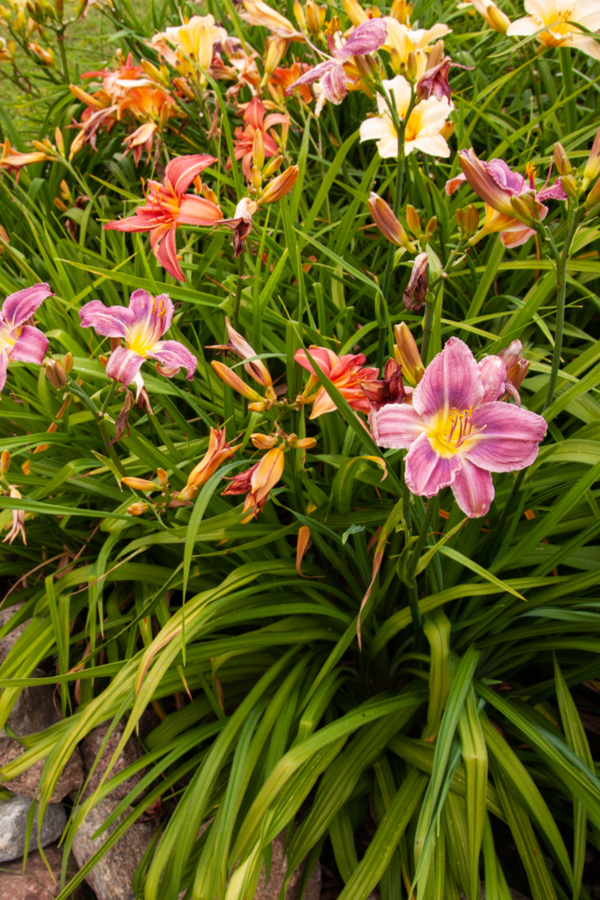If you’re looking for a pop of color in your garden, daylilies are a great option. These hardy flowers come in a variety of colors and bloom from early summer to fall. While daylilies are relatively easy to care for, there are a few things you can do to keep them blooming their best.
- Water your day lilies regularly and fertilize them monthly during the blooming season
- Deadhead spent flowers to encourage more blooms
- Cut back the foliage in late fall or early winter to prevent disease and encourage new growth in the spring
How to Keep Daylilies Blooming
Should I Deadhead My Daylilies?
If you’re like most gardeners, you probably have a few daylilies (Hemerocallis sp.) growing in your garden. These perennial plants are prized for their bright flowers and easy-care nature. But even easy-care plants need a little TLC from time to time.
One of the best things you can do for your daylilies is to deadhead them regularly.
What is Deadheading?
Deadheading is the process of removing spent flowers from a plant.
In most cases, this simply means snipping off the flower stem at its base, just above where it meets the main stem of the plant. Some people also remove any remaining leaves on the stem, but this isn’t strictly necessary.
Why Deadhead Daylilies?
There are two primary reasons to deadhead daylilies: aesthetics and plant health. Let’s take a closer look at each one:
Aesthetics – Once a daylily flower fades and dies, it usually doesn’t look very attractive.
By removing spent flowers, you can keep your plants looking neat and tidy. Plus, it allows new flowers to take center stage and really show off their stuff!
Plant Health – If left unchecked, fading flowers can turn into seed pods on daylilies.
While some gardeners enjoy collecting seeds from their favorite plants, too many seeds can actually be detrimental to a daylily’s health.
Do Daylilies Bloom More Than Once?
Yes, daylilies bloom more than once. In fact, they are one of the few flowers that bloom multiple times during the summer months. Daylilies typically bloom for about six weeks total during the summer.
However, individual blooms only last for a day or two. This means that you will see new blooms opening up every day or two throughout the blooming season.
Why Don’T My Daylilies Bloom All Summer?
One of the most common questions gardeners have about daylilies is why they don’t bloom all summer. The simple answer is that daylilies are not true lilies, and their blooming cycle is different from true lilies. True lilies bloom for a few weeks in early summer and then go dormant for the rest of the season.
Daylilies, on the other hand, bloom sporadically throughout the summer months.
The main reason daylilies don’t bloom continuously is because they need a period of dormancy to rest and recharge. This dormancy period usually occurs during the hottest months of summer when temperatures are too high for optimal growth.
During this time, daylily leaves will turn yellow or brown and die back, but the plant itself will remain alive underground.
Once fall arrives and temperatures start to cool down, daylilies will begin to reemerge and send up new shoots. These new shoots will eventually produce flowers that will bloom in late fall or early winter (depending on your climate).
After blooming, dayliles will once again enter a period of dormancy until spring arrives.
So if you’re wondering why your dayliles aren’t blooming as much as you’d like during the summer months, now you know! Just be patient and wait for them to reemerge in fall – they’ll be sure to put on a beautiful show!
What is the Right Way to Deadhead Daylilies?
Deadheading daylilies is an important part of their care. It helps to encourage new growth and keeps the plants looking tidy. Here are some tips on how to deadhead daylilies:
1. Cut off the spent bloom stems at the base of the plant.
2. Be sure to sterilize your pruning tools before and after use, to avoid spreading diseases.
3. Try to prune in the early morning or evening, when it’s cooler outside.
4. If you see any dead leaves, remove them as well.
5. After deadheading, give your daylilies a good watering if needed.

Credit: oldworldgardenfarms.com
Daylilies Not Blooming
If you’ve noticed that your daylilies aren’t blooming as much as they used to, or if they’re not blooming at all, there are a few possible explanations. First, check to see if the plants are getting enough sun. Daylilies need at least six hours of sunlight per day in order to bloom well.
If they’re not getting enough sun, try moving them to a sunnier location.
It’s also important to make sure that the plants are getting enough water. Daylilies should be watered deeply and regularly during the growing season.
However, over-watering can also be a problem, so make sure that the soil is draining well and that the plants are not sitting in water for prolonged periods of time.
Finally, it could be that the plants are simply too old and need to be replaced. Daylilies typically have a lifespan of about 10 years, so if your plants are older than that it may be time for some new ones.
Daylilies Care And Maintenance
Daylilies are a versatile and easy to care for plant that make a great addition to any garden. With a little basic care, they will thrive and bloom beautifully for many years. Here are some tips on how to keep your daylilies healthy and blooming their best.
Watering: Daylilies prefer moist, well-drained soil. Water them deeply once or twice a week during the growing season, depending on rainfall amounts. Be sure to water early in the day so the leaves have time to dry off before nightfall, which can help prevent fungal diseases.
In hot weather, you may need to water more often.
Fertilizing: A monthly application of balanced fertilizer will give your daylilies the nutrients they need to grow strong and produce lots of flowers. You can also top dress with compost or manure in the spring for an extra boost.
Pruning: Cut back dead or damaged foliage in the fall or early spring. If your plants become overcrowded, you can dig them up and divide them every 3-5 years in early spring. Replant immediately after dividing and water well.
With just a little basic care, your daylilies will thrive and provide you with beautiful blooms year after year!
How to Get Daylilies to Bloom Again
If you want to get your daylilies to bloom again, here are a few tips. First, cut back any dead or dying leaves and flowers. This will help the plant focus its energy on new growth.
Second, fertilize your daylilies with a high-phosphorus fertilizer. This will encourage blooming. Third, make sure your daylilies are getting enough sunlight.
They need at least six hours of sun per day to bloom well. Finally, water your daylilies deeply but infrequently. Deep watering encourages deep roots, which are necessary for strong blooms.
Conclusion
If you want to keep your daylilies blooming throughout the summer, there are a few things you can do. First, make sure they are getting enough sunlight. They should get at least six hours of direct sun each day.
Second, water them regularly. They should be watered deeply about once a week, and more often if it is very hot and dry outside. Third, fertilize them monthly with a balanced fertilizer.
Lastly, deadhead spent flowers regularly to encourage more blooms.






